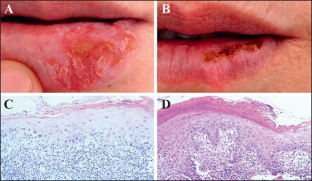Actinic cheilitis – is a chronic disease of the red border of the lips that occurs as a delayed-type allergic reaction in individuals with increased sensitivity to ultraviolet radiation. Predominantly sick men aged 20-60 years in the warm season, with fair skin. In autumn – the winter period of manifestation of actinic cheilitis disappears on its own. What are the forms of actinic cheilitis? Learn aspects of the diagnosis and treatment of actinic cheilitis at estet-portal.com.
What are the forms of actinic cheilitis?
In the mechanism of development of actinic cheilitis lies an allergic reaction of a delayed type. It is provoked by pathological sensitivity to the action of ultraviolet rays. Find out what measures to prevent actinic cheilitis at estet-portal.com. Such sensitization often appears against the background of diseases of the gallbladder, liver and other organs of the gastrointestinal tract – intestinal tract.
Two forms of actinic cheilitis are clinically distinguished:
- In the dry form, the red membrane of the lips, more often than the lower one, becomes bright red and covered with small silvery-white scales. The lesion covers the entire surface of the red membrane of the lips, the upper lip and skin of the face are less often involved in the process. Perhaps the appearance of areas of excessive keratinization of the epithelium of the membrane of the lips, and sometimes even verrucous growths. The patient complains of burning and itching of the lips.
- The clinical picture of the exudative form of actinic cheilitis corresponds to the manifestations of allergic contact cheilitis and is characterized by the appearance of areas of bright red erythema and small vesicles against the background of a slightly swollen red border of the lips. They quickly break with the formation of weeping erosions, on the surface of which crusts and cracks appear. In addition to itching and burning, patients are concerned about the soreness of the lips.

Main aspects of the diagnosis of actinic cheilitis
The dry form of actinic cheilitis is differentiated from the dry form of exudative cheilitis; exfoliative form – from contact allergic, atopic and eczematous cheilitis, as well as from lupus erythematosus lips without atrophy.
Actinic cheilitis can serve as a background for the development of obligate precancerous forms.
Diagnosis of actinic cheilitis is based on the clinical presentation and a typical history. Sometimes questions about the diagnosis, especially with long-term non-healing erosions, cracks and seals in the base, as well as severe keratinization or wart growths, can only be resolved with a histological examination of scrapings from the affected area.
The histological picture is characterized by severe epithelial hyperplasia with slight parakeratosis. The connective tissue layer is swollen, perivascular infiltration, accumulation of homogenized elastic fibers are noted.
What is the treatment for actinic cheilitis?
First of all, the patient should be advised to avoid sun exposure, to change jobs if their conditions affect the state of health.
Topical corticosteroid ointments are used to treat actinic cheilitis; for oral administration, antihistamines, B vitamins (especially B2, B6, B12), nicotinic acid are prescribed.
In prolonged cases, the combined use of antimalarial drugs with low doses of corticosteroids is recommended. By following preventive measures, you can prevent the appearance of actinic cheilitis in the spring.







Add a comment